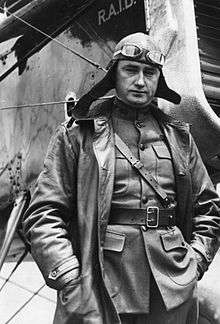Lowell Smith
| Lowell Herbert Smith | |
|---|---|
 | |
| Born |
October 8, 1892 Santa Barbara, California |
| Died |
4 November 1945 (aged 53) Tucson, Arizona |
| Place of burial | Arlington National Cemetery |
| Allegiance | United States of America |
| Service/branch |
United States Army Air Service United States Army Air Corps |
| Years of service | 1917–1945 |
| Rank | Colonel |
| Battles/wars |
Mexican Revolution World War II |
| Awards |
Distinguished Flying Cross Distinguished Service Medal Mackay Trophy |
Lowell Herbert Smith (October 8, 1892—November 4, 1945) was a pioneer American airman who piloted the first airplane to receive a complete mid-air refueling (along with Lt. John P. Richter) on June 27, 1923, and later set an endurance record of 37 hours on August 28, both in a De Havilland DH-4B. Smith also piloted the Douglas World Cruiser Chicago, which along with one other made the first aerial circumnavigation in 1924. Smith held 16 records for military aircraft in speed, endurance and distance.[1] He was awarded the best achievement in flight Mackay Trophy twice.[2]
Biography
Smith was born October 8, 1892 and first became an aviator for the Mexican Army (1915), but in 1917 joined the Army Air Service.
In 1919 he found himself able to participate in the Great Transcontinental Air Race. However, on the evening of October 15 his aircraft was destroyed by fire when lanterns being used by mechanics ignited a wing. Smith received permission to continue the race if he could find a replacement aircraft. Prospects seemed dim until Major Carl Andrew Spaatz arrived on October 17. It took only a little pleading before Spaatz agreed to turn over his plane to Smith. Going on to conquer wind and weather, Smith became the first West Coast flier to complete the round trip when he arrived in San Francisco on October 21.[3]
In 1924, Smith then a lieutenant, was made flight commander of the mission to be the first to fly around the world.[4] Another flyer began leading the flight from Seattle, but crashed his plane in Alaska, therefore, Smith took over leadership of the expedition. During the stopover in Thailand he developed dysentery from which he did not recover until the expeditionary flight was completed.
In 1936, Smith was appointed to the War Department Board for standardizing airplane design and procurement procedures. Under his guidance from February 1942 to March 1943, Davis-Monthan became the top training base for B-17 and B-24 crews during World War II.
Smith died from injuries suffered when he fell from a horse in the Catalina Foothills, Arizona, and was buried at Arlington National Cemetery. Lowell H. Smith Elementary School in Tucson, Arizona was named after him.
Awards
- Distinguished Service Medal
- Distinguished Flying Cross
- World War I Victory Medal
- American Defense Service Medal
- American Campaign Medal
- World War II Victory Medal
MacKay Trophy - twice awarded
Distinguished Service Medal Citation
The President of the United States of America, authorized by Act of Congress, July 9, 1918, takes pleasure in presenting the Army Distinguished Service Medal to Captain (Air Service) Lowell H. Smith, United States Army Air Service, for exceptionally meritorious and distinguished services to the Government of the United States, in a duty of great responsibility during World War I. Lieutenant Smith, as Pilot of the Airplane No. 2, the "Chicago," and later when placed in command of the United States Army Air Service around-the-world flight from 6 April 1924 to 28 September 1924, displayed untiring energy, courage, and resourcefulness during the entire period that the Air Service expedition was upon its hazardous undertaking. His leadership, sound judgment, and tenacity of purpose were material factors in the success of this pioneer flight of airplanes around the world. In the performance of his great task he brought to himself and to the military forces of the United States the signal honor of an achievement which is a testimonial to American thoroughness, courage, and resourcefulness.
General Orders: War Department, General Orders No. 14 (1925)
Action Date: April 6 - September 28, 1924 [5]
Distinguished Flying Cross Citation
The President of the United States of America, authorized by Act of Congress, July 2, 1926, takes pleasure in presenting the Distinguished Flying Cross to First Lieutenant (Air Service) Lowell H. Smith, U.S. Army Air Service, for extraordinary achievement while participating in an aerial flight. Lieutenant Smith and Lieutenant John P. Richter were the pioneers in establishing the practicability in refueling airplanes while in flight, and on 28 - 29 June 1923, they piloted an airplane refueled in flight for 37 hours, 15 minutes and 14 and a half seconds, breaking the endurance record, the speed records from 2,500 to 5,000 kilometers, and the distance record (5,300 kilometers). By their endurance, resourcefulness, and determination they reflected great credit upon themselves and the Army of the United States.
General Orders: War Department, General Orders No. 16 (1929)
Action Date: June 28 - 29, 1923 [6]
References
- ↑ "Lowell H. Smith; Colonel, United States Army". Arlington National Cemetery.net. Retrieved June 11, 2010.
- ↑ http://airandspace.si.edu/explore-and-learn/multimedia/detail.cfm?id=6602
- ↑ William M. Leary. Billy Mitchell and the Great Transcontinental Air Race of 1919
- ↑ National Museum of the Air Force Factsheet for May 2, 1924
- ↑ http://valor.origin-domain.sightlmg.com/recipient.php?recipientid=16839
- ↑ http://valor.origin-domain.sightlmg.com/recipient.php?recipientid=16839
External links
| Wikimedia Commons has media related to Lowell Smith. |